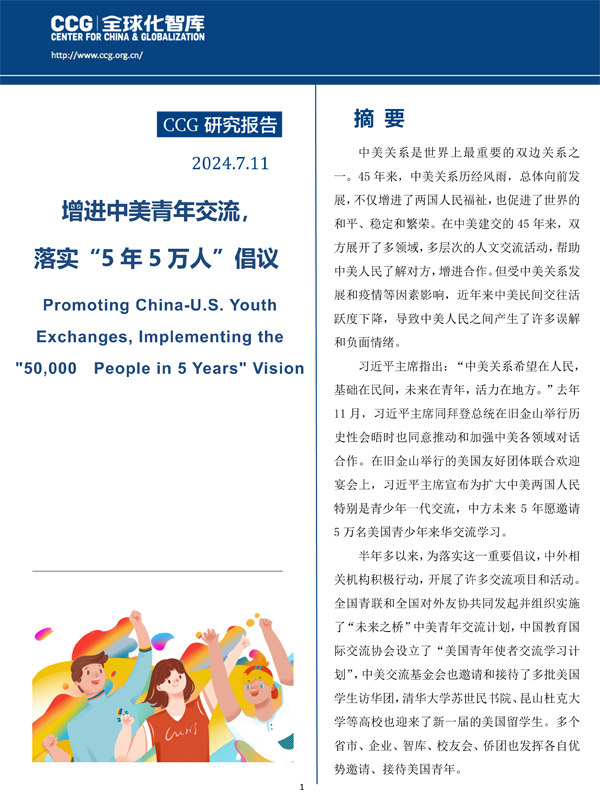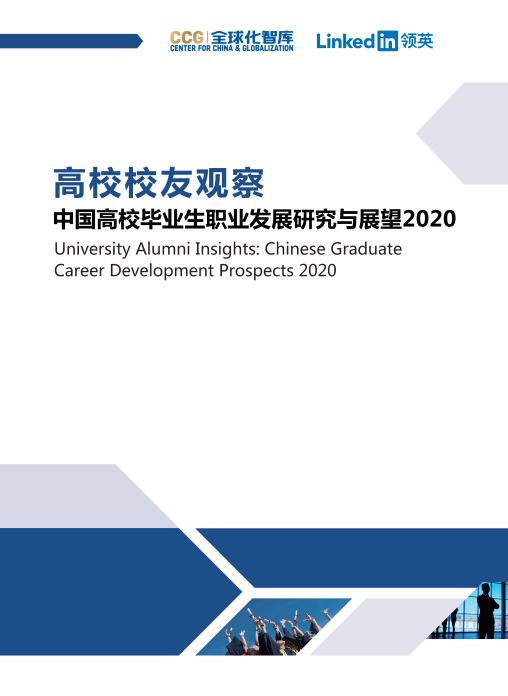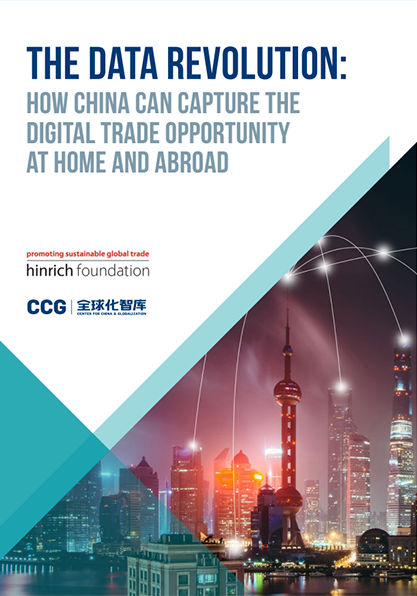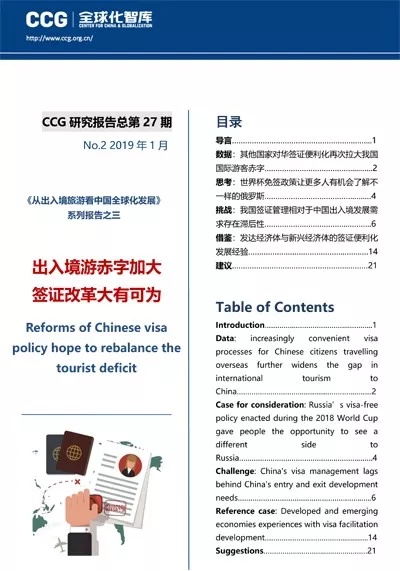Promoting China-U.S. Youth Exchanges, Implementing the “50,000 People in 5 Years” Vision


Abstract
China-U.S. relations are one of the most important bilateral relationships in the world, and over the past 45 years, they have weathered the storms and generally moved forward, not only enhancing the well-being of the people of the two countries, but also contributing to the peace, stability and prosperity of the world. In the 45 years since the establishment of diplomatic relations between China and the U.S., the two sides have carried out humanistic exchanges in many fields and at many levels, helping the Chinese and American people to understand each other and enhance cooperation. However, due to the changes in China-U.S. relations and the epidemic and other factors, the activity of China-U.S. people-to-people exchanges has declined in recent years, leading to many misunderstandings and negative emotions between the Chinese and American people.
President Xi Jinping pointed out that “the hope of the China-U.S. relationship lies in the people, its foundation is in our societies, its future depends on the youth, and its vitality comes from exchanges at subnational levels.” Last November, President Xi Jinping and President Biden also agreed to promote and strengthen China-U.S. dialogue and cooperation in various fields during their historic meeting in San Francisco. At a joint welcome banquet of U.S. friendship groups in San Francisco, President Xi Jinping announced that in order to expand exchanges between the people of China and the U.S., especially the youth generation, China is willing to invite 50,000 U.S. youths to come to China for exchanges and study over the next five years.
Over the past six months or so, in order to implement this important initiative, relevant institutions in China and abroad have taken active steps to carry out a number of exchange programmes and activities. The All-China Youth Federation and The Chinese People’s Association for Friendship with Foreign Countries have jointly initiated and implemented the “Bridge of the Future” China-US Youth Exchange Programme, the China Education Association for International Exchange has set up the “Young Envoys Scholarship”, and the China-United States Exchange Foundation has invited and hosted a number of U.S. student delegations to China. The China-US Exchange Foundation has also invited and hosted several groups of American students to visit China, and colleges and universities such as Schwarzman College at Tsinghua University and Duke Kunshan University have also welcomed a new class of American students. Many provinces, cities, enterprises, think tanks, alumni associations, and overseas Chinese associations have also taken advantage of their respective strengths to invite and host American youth.
According to incomplete statistics, in the past six months, at least 60 China-U.S. youth exchanges have taken place in China, covering 20 provincial administrative regions. American youth visiting China are mainly students, including high school students, college students and graduate students. At the same time, young American entrepreneurs, media professionals, film industry workers, and professionals in fields such as architecture have come to China for exchanges. These programmes and activities cover a wide range of topics such as culture, education, economy, science and technology, international relations, etc. Round-table discussions, art salons, sports competitions, cultural performances and many other forms of activities have been carried out, aiming at letting the youth of the two countries to enhance their understanding, gain friendship and make progress together in mutual learning and appreciation. Among these activities, “Bond with Kuliang: 2024 China-U.S. Youth Festival”held in Fuzhou gathered more than 500 young people from all walks of life in China and the United States, making it the largest youth exchange activity since the establishment of diplomatic relations between China and the United States.
However, it is also important to recognize that the positive momentum of China-U.S. youth exchanges faces multiple challenges and uncertainties. The U.S. Department of State still classifies travel to mainland China as “Tier 3” and advises its citizens to “reconsider whether or not to travel”, which discourages some American youth who had thought of visiting China. Flights between China and the United States are still inadequate compared to the pre-epidemic period, making it difficult for young people who are economically disadvantaged to afford the relatively high cost of travel. At the same time, the negative voices and sentiments in the U.S. elections, media, and public opinion, as well as differences in the appeal of popular culture, also deserve attention and concern.
In this context, in order to further promote China-U.S. youth cultural exchanges and implement President Xi Jinping’s initiative, this report puts forward the following recommendations based on research and analysis:
(I) In order to jointly implement the “50,000 in 5 Years” vision and to enhance the depth and breadth of youth exchanges between the U.S. and China, we advocate the active participation and innovative cooperation of multiple actors.
1.Youth Ambassadors in Colleges and International Schools.
We can select 1,000 outstanding colleges and universities in China, and using school dormitories and teaching facilities, each school will be responsible for 50-100 U.S. students to come to study abroad in the summer. You can select 500 outstanding middle schools in China, and each middle school will invite 30 outstanding U.S. middle school students to come to organize summer camps and other activities.
2.Vitality engine for local governments and China-US-Friendship Cities.
A group of local governments in various provinces and cities, including Xinjiang, Tibet, Yunnan, Inner Mongolia, Heilongjiang, and other border and western regions, can be selected to undertake a certain amount of U.S. youths on a local basis and carry out special exchange activities by combining local characteristics and U.S. youths’ hobbies and professional specialties. At the same time, the platform of China-US friendship cities can be utilized to promote mutual cooperation and friendship among people.
3. Collaborative Networks of People’s Organizations and Social Groups
National and local associations for friendship with foreign countries, youth federations, and public diplomacy associations can play a better role in providing guidance and coordinating by enhancing resource integration and coordination mechanisms, and planning and conducting impactful exchange activities.
4. Resource Bridges of International Institutions
Relevant international exchange foundations, international organizations, and multinational enterprises can better leverage their extensive global networks and resources, especially the U.S. human resources channels, to build a smooth channel for youth exchanges between China and the United States, and to promote in-depth cooperation between the two sides in the fields of education, science and technology, culture and other areas.
5. Emotional Links of Alumni Networks
The deep community resources of organisations such as European and American alumni associations and alumni associations should be brought into play to strengthen the links between Chinese in the United States and American alumni and their descendants, so as to build a network of Chinese in the United States that resonates with emotions and shares resources and provides more opportunities and platforms for them to return to their home countries for study visits and exchanges, fellowships and friendships, study tours and internships.
6. Knowledge Bridges of Think Tanks and Research Institutions
Think tanks and research institutions can actively engage in people-to-people diplomacy and academic exchanges, organizing meetings and forums, facilitating mutual visits of young scholars and researchers, thereby enhancing mutual understanding and respect among young scholars from both countries and injecting wisdom and momentum into the long-term development of China-U.S. relations.
(II) More efforts should be made to encourage and attract a wider range of American school-age children and youth to travel, exchange, and study in China, including promoting diverse exchange formats, innovative activities, market-oriented products, and stronger preferential policies.
7.Innovate Exchange Methods and Explore Diversified Needs.
We should keep abreast of the times and design rich and diversified forms of exchange and innovative activities, such as scientific and technological exploration, art exchanges, sports competitions, etc., so as to accurately match the interests and expectations of American youth and expand the scope of groups from the U.S. side coming to China.
8. Combine Inbound Tourism with Study Tours, Stimulating the Enthusiasm of Tourism and Related Enterprises to Participate, and Creating more market-oriented study tour products.
Reduce the cost for American youth to come to China and ensure a high-quality travel and learning experience by leveraging both policy subsidies and market mechanisms.
9. Continuously Optimize Policies to Make Visits to China More Convenient, Reduce their cost of coming to China.
Further optimize visa policies, streamline entry procedures, pilot unilateral visa-free policies for qualified American youth coming to China, Coordinating with airlines, tourist attractions, railroads and others to offer discounted fares for U.S. youth coming to China, reduce their cost of coming to China, and improve the experience for American youth visiting China.
(III) Increase educational communication and student exchanges between China and the US to attract more American students to study and participate in exchange programs in China.
10.Increase Publicity and Adopt More Outward-Looking Enrollment Strategies to Actively Explore the Market for American Students Coming to China.
Enhance brand-building and international promotion, drawing on globally recognized education marketing strategies. Target the U.S. audience accurately, showcasing the unique appeal and extensive opportunities of Chinese education to stimulate greater interest and desire among American students to study in China.
11.Enhance the internationalization of the faculty team, improve the quality of teaching for international students in China.
We should strongly introduce overseas returnees and foreign teachers. This will enrich the international background of the teaching team, enhance the cutting-edge and practical nature of the curriculum. We need to establish a fair and transparent quality assessment system to guarantee the value of studying in China and boost the international recognition of the Chinese education brand.
12. Chinese schools can try to conduct more homestay programs than just arranging dormitories for international students. The homestay model is an excellent way to help American students get to know the Chinese people and a typical Chinese family, and it also provides host families with the opportunity to engage with a foreign culture, which can help promote two-way cultural exchange and mutual learning.
13. Further exploring the development of Chinese-foreign cooperative education programs. It can further explore the development of Chinese-foreign cooperative education institutions and programs, expand the scale of Chinese-foreign cooperative education, adjust the structure of the regional allocation of resources for Chinese-foreign cooperative education, and use Chinese-foreign cooperative education institutions and programs as an important channel for recruiting U.S. students to China.
14. Incorporate U.S. parents’ and students’ considerations of studying in China for their careers into the design and promotion of study abroad programs. Try to follow the example of the U.S. OPT (Optional Practical Training) program for international students, and innovate visa policies to provide U.S. students coming to China with internship or work visas similar to the U.S. OPT program. Allow students to do internships or work in China for one to two years after completing their studies, providing them with practical work experience and career development opportunities, as well as career guidance services.
(IV) Strengthen international communication, shape a positive image of China-U.S. youth exchanges, and build a more open, transparent, and friendly international communication environment to create a favorable public opinion for China-U.S. youth exchanges and American youth studying in China. Further enhance the goodwill and understanding of the American public towards China, and promote mutual understanding and friendship between the peoples of the two countries.
15. Emphasize International Communication of Activities, Innovate Communication Strategies, and Expand International Influence.
Use vivid, lively, and innovative way for communication, integrate traditional and new media platforms such as social media, short videos, and live streaming to tell authentic, multidimensional, and comprehensive Chinese stories, especially successful cases of China-U.S. youth exchanges. This will inspire resonance and positive feedback from the international community.
16. Deepen Cooperation with International Media to Amplify the Effects of International Communication.
Strengthen cooperation with international media and publishing institutions, leveraging their extensive global networks and professional perspectives to convey China’s voice, explain Chinese policies, eliminate misunderstandings, and guide international public opinion to form a more objective and fair view of China, especially in promoting exchanges between Chinese and American youth, showcasing China’s open, inclusive, and cooperative attitude and practices.
17. Cultural Empowerment to Enhance International Appeal.
Continuously nurture cultural soft power, taping and carrying forward the contemporary value of excellent traditional Chinese culture, and promote the innovation and development of Chinese pop culture to make it serve as a conduit linking China to the global community, with a special focus on captivating the youth demographic in the United States and worldwide. Showcase the vitality and creativity of China’s young generation and enhance overseas youth’s sense of recognition and yearning for Chinese culture through music, film, literature, art, sports and other cultural carriers
18. Fifteenth, the vision should lead the way in enhancing humanistic exchanges.
Taking the “50,000 people in five years” vision as a guide for action, we will comprehensively promote the breadth and depth of China-U.S. people-to-people exchanges, not only in the field of education, but also in science and technology, culture, sports, sustainable development and other areas, so as to promote direct contact and dialogue between people of the two countries, especially young people. Through friendly exchanges and practical cooperation among the people of China and the United States, mutual understanding and trust will be enhanced, the important position of China-U.S. people-to-people diplomacy as an enabler of relations between the two countries will be consolidated, and a solid foundation of public opinion will be laid for the long-term development of China-U.S. relations.







